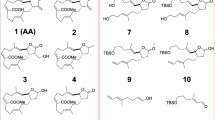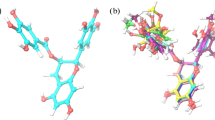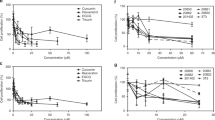Abstract
Curcumin (diferuloyl methane) and its naturally occurring analogs viz. demethoxy, bisdemethoxy and cyclocurcumin, present in rhizomes of curcuma species turmeric, have been shown to inhibit the proliferation of a wide variety of tumor cells. Target nuclear protein HPV 16 E6 (PDB ID: 2fk4) is the major protein actively participating in oral and cervical cancers. In silico studies indicate that curcumin and its natural analogs have effective binding with different active sites on HPV 16 E6 protein, ideal target for restoring the tumor suppressor function of p53 and thus allowing the apoptosis of infected cells. The main limitation in the use of curcuminoids as therapeutic agents is their low bioavailability. Since piperine is known to enhance curcumin bioavailability to more than two thousand times by inhibiting its efflux, a conjugate of curcumin-piperic acid was also used. Although curcumin has been found to have strongest binding with this target and the two curcuminoids, demethoxy and bisdemethoxy curcumin have lower but comparable affinity, chlorogenic acid amongst the naturally occurring analogs has been found to have best binding affinity amongst all the analogs. Although curcumin-piperoyl conjugate does not show very encouraging results, it is likely to have potential activity in vitro and in vivo. These results throw light on the SAR of curcuminoids, leading to future designing of potent, non-toxic drugs for oral and cervical cancers.
Similar content being viewed by others
References
Anand, P., Thomas, S.G., Kumar, A., Kunnumakkaram, B., Sundaram, C., Misra, K., Priyadarsini, I.K., Rajasekharan, N.K., Aggarwal, B.B. 2008. Antioxidant, anti-inflammatory, anticancer, anticarcinogenic, antidiabetic and neuroprotective effects of curcuminanalogues (congeners) made by man and mother nature (review). Biochemical Pharmocolgy 76, 1590–1611.
Baleja, J.D., Cherry, J.J., Zhiguo, L., Gaob, H., Nicklaus, M.C., Johannes, H.V., Jason, J.C., Elliot, J.A. 2006. Identification of inhibitors to papillomavirus type 16 E6 protein based on three-dimensional structures of interacting proteins. Antiviral Res 72, 49–59.
Campisi, G., Giovannelli. L. 2009. Controversies surrounding human papilloma virus infection, head & neck vs. oral cancer, implications for prophylaxis and treatment. Head Neck Oncol 1, 1–8.
Chakravarti, N., Jeffrey, N., Myers, N., Aggarwal, B.B. 2006. Targeting constitutive and interleukin-6-inducible signal transducers and activators of transcription 3 pathway in head and neck squamous cell carcinoma cells by curcumin (diferuloylmethane). Int J Cancer 119, 1268–1275.
Clifford, G.M., Smith, J.S., Plummer, M., Munoz, N., Franceschi, S. 2003. Human papillomavirus types in invasive cancer worldwide: A meta-analysis. Br J Cancer 88, 63–73.
Degenkolbe, R., Gilligan, P., Gupta, S., Bernard, H.U. 2003. Chelating agents stabilize the monomeric state of the zinc binding human papillomavirus 16 e6 oncoprotein. Biochemistry 42, 3868–3873.
Doorbar, J. 2006. Molecular biology of human papillomavirus infection and cervical cancer. Clin Sci 110, 525–541.
Füllbeck, M., Huang, X., Dumdey, R., Fromme, C., Dubiel, W., Preissner, R. 2005. Novel curcuminand emodin-related compounds identified by in silico 2D/3Dconformer screening induce apoptosis in tumor cells. BMC Cancer 5, 97.
Glusker, J.P. 1998. Directional aspects of intermolecular interactions. In: Weber, E. (Ed.) Topics in Current Chemistry Design of Organic Solids, Springer-Verlag, Berlin and Heidelberg, 1–56.
Kapoor, N., Sharma, A., Dwivedi, V., Kumar, A., Pati, U., Misra, K. 2006. Telomerase targeted anticancer bioactive prodrug by antisense based approach. Cancer Lett 248, 245–250.
Lin, L., Shi, Q., Nyarko, A.K., Bastow, K.F., Wu, C.C., Su, C.Y., Shih, C.C., Lee, K.H. 2006. Design and synthesis of new curcumin analogues as potential antiprostate cancer agents. J Med Chem 13, 3963–3972.
Mantovani, F., Banks, L. 2001. The human papillomavirus E6 protein and its contribution to malignant progression. Oncogene 20, 7874–7887.
Mishra, S., Kapoor, N., Mubarak, A., Pardharasaradhi, B.V.V., Kumari, L., Khar, A., Misra, K. 2005a. Differential apoptotic and redox regulatory activities of curcumin and its derivatives. Free Radic Biol Med 38, 1353–1360.
Mishra, S., Narain, U., Mishra, R., Misra, K. 2005b. Design development and synthesis of mixed bioconjugates of piperic acid-glycine, curcumin-glycine/alanine and curcumin-glycine-piperic acid and their antibacterial and antifungal properties. Bioorg Medicinal Chem 13, 1477–1486.
Nomine, Y., Charbonnier, S., Ristriani, T., Stier, G., Masson, M., Cavusoglu, N., Dorsselaer, A.V., Weiss, E., Kieffer, B., Trave, G. 2003. Domain substructure of HPV E6 oncoprotein: Biophysical characterization of the E6 C-terminal DNA-binding domain. Biochemistry 42, 4909–4917.
Nomine, Y.S., Charbonnier, L., Miguet, N., Potier, A.V., Dorsselaer, R.A., Atkinson, G.T, Kieffer, B. 2005. (1) H and (15) N resonance assignment, secondary structure and dynamic behaviour of the Cterminal domain of human papillomavirus oncoprotein E6. J Biomol NMR 31, 129–141.
Nomine, Y.M., Masson, S., Charbonnier, Z.K., Ristriani, T., Deryckere, F., Sibler, A.P., Desplancq, D., Atkinson, R.A., Weiss, E., Orfanoudakis, G., Kieffer, B., Trave, G. 2006. Structural and functional analysis of e6 oncoprotein: Insights in the molecular pathways of human papillomavirus-mediated pathogenesis. Mol Cell 21, 665–678.
Ohtsu, H., Xiao, Z., Ishida, J., Nagai, M., Wang, H.K., Itokawa, H., Su, C.Y., Shih, C., Chiang, T., Chang, E., Lee, Y., Tsai, M.Y., Chang, C., Lee, K.H. 2002. Antitumor agents. 217. Curcumin analogues as novel androgen receptor antagonists with potential as antiprostate cancer agents. J Med Chem 23, 5037–5042.
Peng, S., Ji, H., Trimble, C., He, L., Tsai, Y.C., Yeatermeyer, J., Boyd, D.A.K., Hung, C.F., Wu, T.C. 2004. Development of a DNA vaccine targeting human papillomavirus type 16 oncoprotein E6. J Virol 78, 8468–8476.
Ravindran, J., Prasad, P., Aggarwal, B.B. 2009. Curcumin and cancer cells: How many ways can curry kill tumor cells selectively? AAPS J 11, 495–510.
Shoba, G., Joy, D., Joseph, T., Majeed, M., Rajendran, R., Srinivas, P.S.S.R. 1998. Influence of piperine on the pharmacokinetics of curcumin in animals and human volunteers. Planta Med 64, 353–356.
Singh, N. 2005. HPV and cervical cancer-prospects for prevention through vaccination. Indian JMed Paediatr Oncol 26, 20–23.
Ullman, C.G., Haris, P.I., Galloway, D.A., Emery, V.C., Perkins, S.J. 1996. Predicted α-helix/β-sheet secondary structures for the zinc-binding motifs of human papillomavirus E7 and E6 proteins by consensus prediction averaging and spectroscopic studies of E7. Biochem J 319, 229–239.
William, H.W. 2009. The changing face of head and neck cancer in the 21st century: The impact of HPV on the epidemiology and pathology of oral cancer. Head and Neck Pathol 3, 78–81.
Author information
Authors and Affiliations
Corresponding author
Rights and permissions
About this article
Cite this article
Singh, A.K., Misra, K. Human papilloma virus 16 e6 protein as a target for curcuminoids, curcumin conjugates and congeners for chemoprevention of oral and cervical cancers. Interdiscip Sci Comput Life Sci 5, 112–118 (2013). https://doi.org/10.1007/s12539-013-0159-8
Received:
Revised:
Accepted:
Published:
Issue Date:
DOI: https://doi.org/10.1007/s12539-013-0159-8




